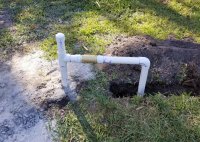Greetings,
I recently had a new well drilled. I hooked it up to existing equipment with the plan to get a water test and purchase new equipment. The treated water was acceptable for a couple of weeks, then sulfur smell started to creep in. It has only gotten worse. I'm hoping to get advice on narrowing down the exact cause and how to adequately address it when I install new equipment.
Water test results attached.
Current Setup
Well Depth = 117' including a 25' well screen at the bottom
Check valve at the top of the well casing.
Current Equipment & order from the well: Goulds shallow Well jet pump --> 65 gal pressure tank --> 10x4.5" sediment filter (1 micron at the moment) --> 1.5cf water softener with a fleck 5600 mechanical valve --> chlorine pellet feeder (I think it is an Automated Pure Water branded model 400 feeder) --> 1.5cf GAC with a fleck 5600 mechanical valve.
New Equipment En Route
2.0cf water softener with a fleck 2510SXT
2.0cf Jacobi catalytic carbon filter with a Fleck 2510SXT AIO oxygen chamber system
No chemical feeder currently
I was able to deal with the sulfur smell, unbearable as it was, until the water started to turn dark grey! This is the treated water, including hot and cold. It can come out of the tap already dark or it can come out clear-ish and darken over several minutes. I cranked up the hot water heater to 140F which helped the hot water smell. Cold water still smells though. I cleaned the pellet feeder and adjusted it to its max setting (60PPM chlorine injection). I'm still getting sulfur smell, though it might have helped a bit with the water color.
Here is a video I took of the treated water as I add a capful of liquid bleach. The water turns from dark grey to clear within seconds. Sulfur reducing bacteria?
I recently had a new well drilled. I hooked it up to existing equipment with the plan to get a water test and purchase new equipment. The treated water was acceptable for a couple of weeks, then sulfur smell started to creep in. It has only gotten worse. I'm hoping to get advice on narrowing down the exact cause and how to adequately address it when I install new equipment.
Water test results attached.
Current Setup
Well Depth = 117' including a 25' well screen at the bottom
Check valve at the top of the well casing.
Current Equipment & order from the well: Goulds shallow Well jet pump --> 65 gal pressure tank --> 10x4.5" sediment filter (1 micron at the moment) --> 1.5cf water softener with a fleck 5600 mechanical valve --> chlorine pellet feeder (I think it is an Automated Pure Water branded model 400 feeder) --> 1.5cf GAC with a fleck 5600 mechanical valve.
New Equipment En Route
2.0cf water softener with a fleck 2510SXT
2.0cf Jacobi catalytic carbon filter with a Fleck 2510SXT AIO oxygen chamber system
No chemical feeder currently
I was able to deal with the sulfur smell, unbearable as it was, until the water started to turn dark grey! This is the treated water, including hot and cold. It can come out of the tap already dark or it can come out clear-ish and darken over several minutes. I cranked up the hot water heater to 140F which helped the hot water smell. Cold water still smells though. I cleaned the pellet feeder and adjusted it to its max setting (60PPM chlorine injection). I'm still getting sulfur smell, though it might have helped a bit with the water color.
Here is a video I took of the treated water as I add a capful of liquid bleach. The water turns from dark grey to clear within seconds. Sulfur reducing bacteria?


